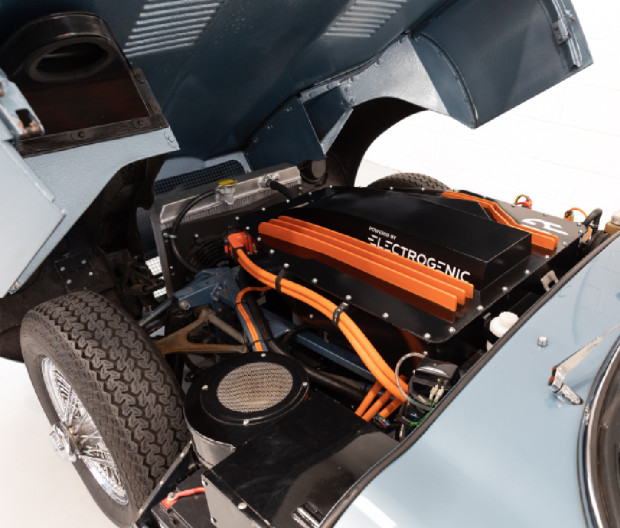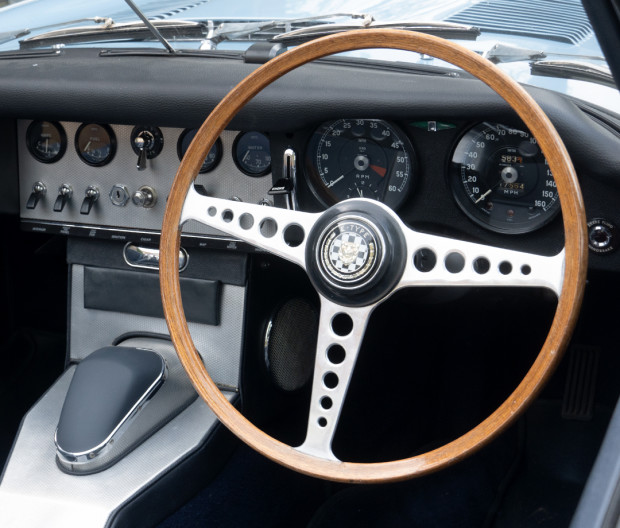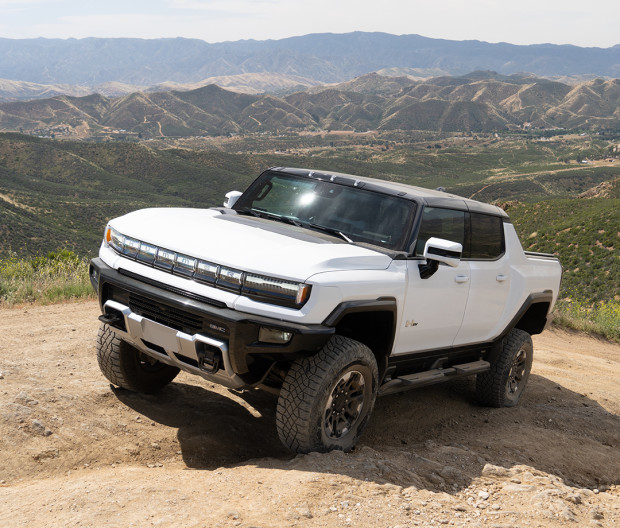The increasingly popular trend of electric conversions sure seems to attract a lot of hate online these days. Electrified classic Porsches and GT40s, electric Jeeps and Land Rovers and Mini Coopers—the list of icons now easily swapped to EV power goes on and on, almost as endlessly as the incessant complaining that each build seems to produce online.
First of all, to 99.9 percent of the keyboard warriors out there: It’s not your car, stay out of it.
Second of all, it’s not your car, so stay out of it!
We all probably obsess over automobiles too much, anyway, projecting our identity into style, performance, capability, or even daily commuting. But the entire societal concept of cars is always changing. Right now it's integrating the promise of a fast and quiet electric future into the fading fever dream of loud and brutish gasoline power. It's just usually at a slow enough pace to keep most of us blissfully unaware of our gradually evolving and accepting mindset.
Imagine Karl Benz or Henry Ford trying to comprehend a 1,577-horsepower Bugatti Chiron Super Sport a century ago. Would they whine that automobiles had become something more than they could imagine? Start with the miracle material of carbon fiber, then add the 3D-printed titanium, and finally the sheer breakneck power—that machine would be so far beyond the plane of existence compared to any then-imagined future horseless carriage. Or, equivalently, if Ferdinand Porsche was confronted with the current electric Taycan Turbo S, a hybrid performance car packed to the carbon with mind-altering tech.
These true modern miracles of engineering are examples of what mankind can ply from raw elements and create on four wheels, but that automotive vision isn't just limited to being tied to an internal combustion engine. And if purists want to fall back on the arguement that we've always been motoring around belching fumes and guzzling gas, they'll first need to recognize that the stuff of speeding dreams back in the early days of the automobile included Ferdinand Porsche inventing a record-setting electric car with hub-mounted motors—more than 100 years ago.

Courtesy Image
What’s Lost in the Mix
Complaints about electric conversions killing the souls of classic cars tend to focus on the loss of internal-combustion sounds and, for those refined connoisseurs among us, the smells. But engagement with any car involves all six senses—especially proprioception, essentially our sense of movement. The instant torque of modern EVs will light up a driver's proprioception unlike any street-legal gas car can.
Every electric conversion project starts with the assumption that some of the rumble and some of the gasoline vapors and even some of the vibrations produced as internal combustion winds up into high revs converting torque into horsepower will, unavoidably, be lost.
But every builder attempts to highlight what’s gained: more torque available instantly, in many cases more horsepower as well, plus theoretical eco-friendliness and cutting-edge technological engineering prowess.
Related: Pikes Peak 2023: EVs Join the Party at the Epic Mountain Race
But the real challenge often isn’t how to actually do an electric conversion. Instead, the hardest and most important choice involves which car to use as the platform. For the past few years, cruisers and luxury vehicles fit the bill quite well given the added weight of battery packs. But we’re right at the cusp of making powerful and lightweight sports car conversions possible, with enough range for a fun drive if not true road-tripping.
I’ve driven more than a few EV conversions now, including a Cobra, a 964-generation Porsche, and most recently, an E-Type Jag built by Electrogenic in the United Kingdom. And perhaps out of all, the E-Type (EV-Type?) made the case for accepting electric conversions in classics stronger for me than any other.

Courtesy Image
Electrogenic’s E-Type Jag EV
This customer build started life as a 1962 Series 1 Roadster, an undeniable icon in the original sense of the word. Of course, out comes that original silky-smooth inline-six. But in the modern era of 3D scanning and CAD designs, Electrogenic can swap in the electric drivetrain without chopping the Jag’s chassis at all. In fact, the entire process is theoretically reversible—the batteries drop into the engine bay, with a motor behind that bolts onto the prop shaft. Out come the fuel tank and exhaust system, too.
The system puts down 460 lb-ft of torque with around 150 miles of range from a 43-kWh battery pack depending on driving conditions and driver style. Most impressively, the Jag’s overall weight drops by nearly 200 pounds—while improving weight distribution by moving 66 pounds over the rear axle, which not only means better tire grip while punching the throttle but also lighter steering since the nose now weighs about 120 pounds less.
Electrogenic’s batteries allow for a full fast charge in only 50 minutes, while regen helps to keep brake wear to a minimum. But a big part of the job involves heightening those other senses. That’s why Electrogenic keeps the old-style gauges just in front of the driver’s eyes, rather than swapping in a digital cluster in the center console. And instead of a modern push-button gear selector or dial, the original choke lever now controls Park, Drive, and Neutral with old-school tactile satisfaction.

Courtesy Image
On a quick spin in the pastoral English countryside, my eyes and ears discovered another level of advantages to the electric conversion of this stately convertible. All of a sudden, the soundtrack of birds and trees and babbling brooks play a role in driving. The smells of fresh-cut grass, livestock (for better or worse), and hints of rain to come are no longer masked by carbureted petrol.
Then I punched the gas pedal—not a throttle, maybe the “go” pedal—giving the electric motor a chance to prove how much torque makes a difference in the real world. Not fast, to be fair, but certainly quicker than a 60-year-old car has any right to drive.
Pitching into a slight corner, the improved weight distribution reminds me of a “transaxle” Porsche’s balance, albeit with softer suspension more in line with the cruiser mentality that the E-Type always inhabited.
Not bad—in fact some might say a job well done and dusted, sorted with a cheeky British wave goodbye to fiddling with the choke or syncing carburetors on a cold, foggy morning in Hertford, Hereford, or Hampshire.

Michael Teo Van Runkle
An Electrifying Learning Curve
Electric conversions are pretty impressive when done right. I’ve also off-roaded an all-electric 4x4, which added a whole new level of sensory perception to my comprehension of tire grip in dirt and sand. All of a sudden, my ears pricked up for the sounds of rock and sand crunching and scrabbling as tires clawed for grip, which allowed me to more finely tune throttle input and better guide the wheels through upcoming obstacles.
And to be fair, a learning curve still exists. The magic of driving by fire tamed in a cylinder is lost…In many builds, throttle modulation can sometimes feel like an on-off switch and low-speed torque delivery can get a bit lurchy, while traction control systems still need refinement. And we can all definitely agree that fake internal-combustion engine noises make every EV conversion worse.
Yes, I’d still probably take an original Jaguar V12—but there’s no accounting for taste and once again, it’s not my car so I’ll stay out.
Related: Drive the World's Fastest EVs: Best Electric Cars of 2023
Plenty of customers who value cutting edge tech clearly exist for these conversions, hence Electrogenic’s current lineup of Series Land Rovers, Defenders, Mini Coopers, and 911s.
Now throw in the fact that electric conversions help keep old cars on the road, as time takes its toll but legislation also makes registration harder seemingly every passing year. Anything that helps to expand the base of classic car enthusiasts, especially those who can afford an electric conversion to the tune of six figures, will undoubtedly keep our beloved classics running longer, even if they’re running different.
But don’t forget, electrons are fuel, too. Re-up on your middle-school quantum physics watching Oppenheimer and let other people theorize how their own cars should drive. Meantime, shouldn’t you be out there checking your oil and coolant and air filter and endlessly adjusting a leaky carb?
-----------------------------
By: Michael Teo Van Runkle
Title: EV Conversions of Classic Cars Are Making Driving Better
Sourced From: www.mensjournal.com/gear/classic-ev-conversions-making-driving-better
Published Date: Thu, 31 Aug 2023 16:44:49 GMT
Did you miss our previous article...
https://conservativedailytimes.com/health-fitness/scientists-have-identified-the-lyme-disease-genes-responsible-for-severe-symptoms
.png)





